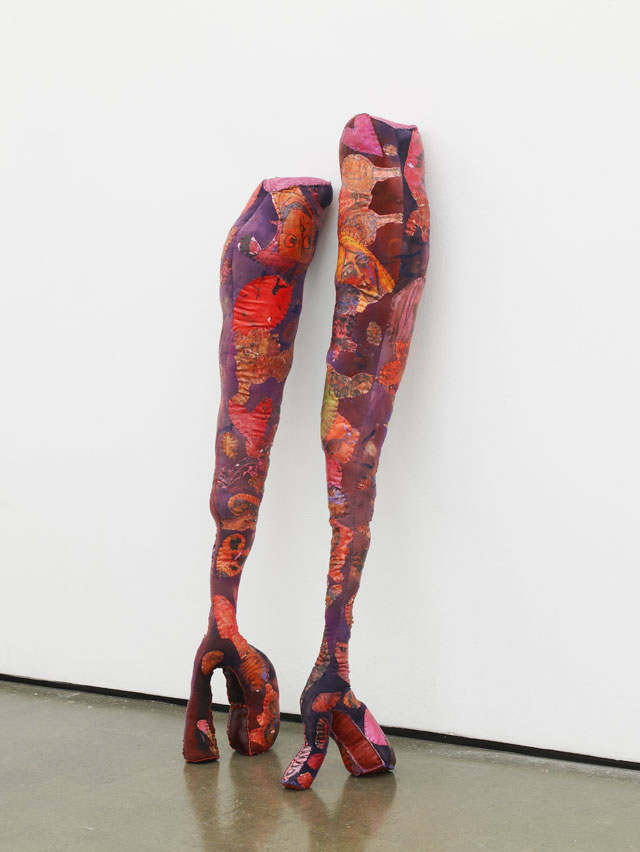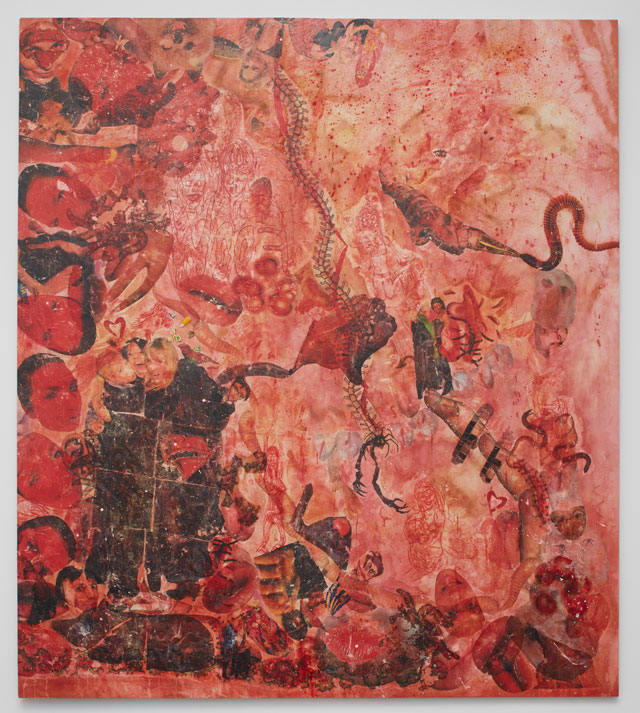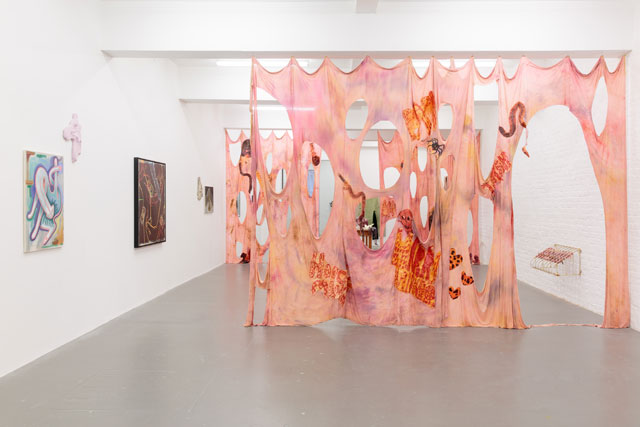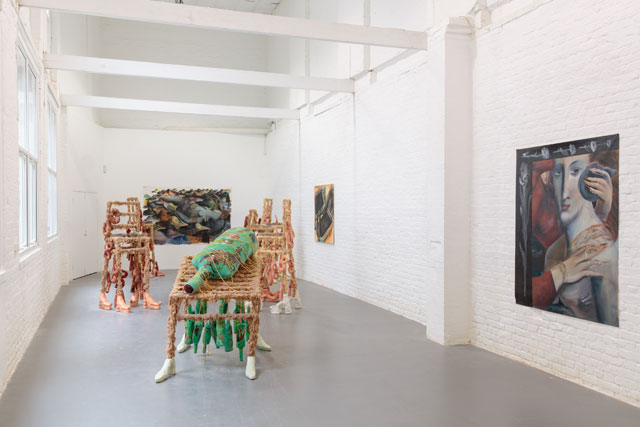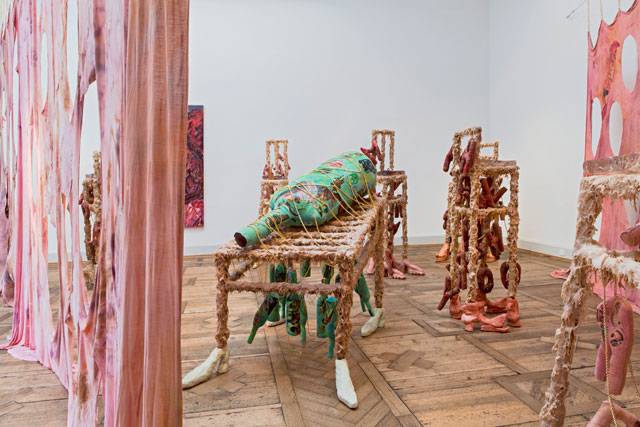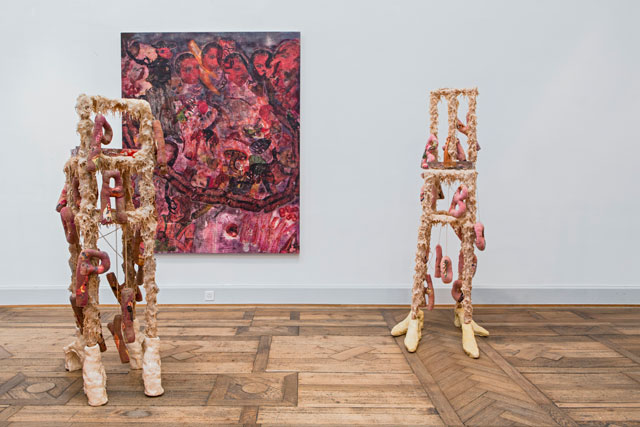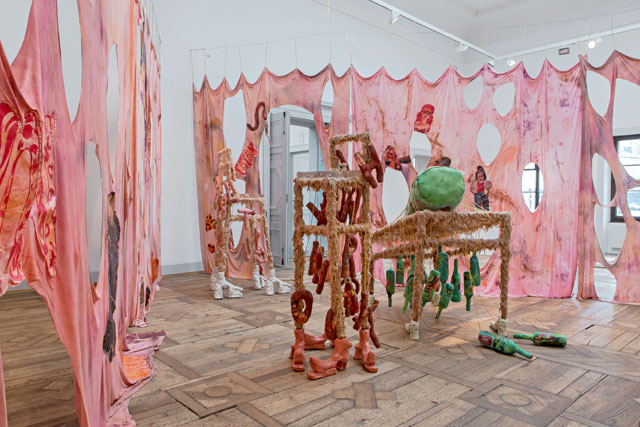

by IZABELLA SCOTT
In Canadian-born artist Athena Papadopoulos’s installation The Great Revel of Hairy Harry Who Who: Orgy at the Onion Cellar (2015–6) – on show in the joint exhibition Streams of Warm Impermanence at DRAF in London – bedraggled chairs with shoes on their feet are doing the conga. Tablecloths stained pink with wine and cough syrup hang from the walls. Bedsheets display the skidmarks of self-tanner. Who has partied this night away? A set of reckless teenagers, or their overpreened counterparts, the nipped and tucked faces that refuse to age?
Papadopoulos (b1988) works across painting, drawing, textiles and collage to create messy, domestic installations, which draw inspiration from her childhood in Toronto during the 1990s, and her Greek father, a fur dealer and womaniser. A set of jezebels and rowdy cougars run through her work, figures tattooed on to her canvases or doodled on her sculptures, as do illustrations of Papadopoulos herself. She is photographed in disguise, or hidden in objects that reference feverish consumer desires of susceptible teenagers – must-have handbags, high heels and T-shirts, wedged on to table legs or strung across her frames.
Papadopoulos’s autobiographical bent is one of self-parody, but it is only a step away from self-harm. In Rancho Rat-King-Cougar (2015), an installation at Supportico Lopez in Berlin, a series of paintings made on bedsheets and stained with hair dye, henna and lipstick hung on the gallery walls. Stitched out of foam and stacked like logs, piles of rotting human limbs littered the floor – a reference to her grandmother, who died following a leg amputation caused by complications from diabetes. The meaty, cartoonish legs hold in suspense the humour and violence that run in equal measure through Papadopoulos’s work.
I meet Papadopoulos in Bermondsey, south London, in the run up to her next show: an installation of a meat locker interior at Shoot the Lobster, New York. Dressed in a pair of paint-streaked pool sliders and an incongruous felt hat, Papadopoulos leads me to her sunlit studio, a surprisingly decorous room with a row of banana plants that glow luminous along a large iron sill. We graze past a rack of foam carcasses – works in progress – before Papadopoulos ensconces herself on a dainty mauve sofa. The wooden floor below us is stained red. “Have you slaughtered an animal,” I ask. She smiles and offers me strawberry juice from her minibar. A soft electro soundtrack plays from hidden speakers and I have the feeling I am here not only to interview Papadopoulos, but also to watch her show. In this room, the border between the artist and her work is decidedly unstable.
Izabella Scott: The Great Revel of Hairy Harry Who Who: Orgy at the Onion Cellar is an amazing name for a show. I wonder if you’re making a reference to a group of painters known as The Hairy Who, or the Chicago Imagists, working in the 1960s. Jim Nutt was one of its members.
Athena Papadopoulos: It’s simpler than that. I was imagining a festivity of some sort, and the Hairy Harry Who Who are set of figurative, personified, hairy chairs that I think of as women. They are at a party together and I was thinking of the student parties in the black comedy The Rules of Attraction (2002), where they have epically named parties like The End of the World Party. The Great Revel is in this vein. The second part of the title, Orgy at the Onion Cellar, is something from Günter Grass’s 1959 novel The Tin Drum. My favourite part was a scene when the characters cut onions because they want to feel something. They’re stunted and so they cut onions together to generate emotion, and eventually they cry together. The hairy chairs are just objects, but they’re trying to be human. If they’re in the onion cellar, maybe they’ll have emotions.
IS: Do you try to hint at a narrative through the materials you use? The bedsheets, for example.
AP: Materials are also allusions. I almost only ever do paintings on tablecloths or bedsheets, because canvases don’t make sense to me. The tablecloth, which I stain pink and hang near the chairs, might suggest there’s been a messy, fictional party. Or the dirty bedsheets might hint that it’s an after-sex scene. There’s a domestic reference in everything I do.
IS: There are definitely hints at a party in The Great Revel … and the female characters you describe via your chairs seem to have been revelling through the night. You have described them as “bedraggled”. Are they older women?
AP: From a very young age, I was surrounded by cougars. My dad is in the fur business, and a lot of women are attracted to fur coats. Actually, I think of these women as reverse cougars, because they might have been in their 30s, but they looked old – at least to my young eyes – because of all the makeup they wore. They were over-jewelled, over-tanned, and bedraggled. I was surrounded by these women as a kid. These women are my muses.
IS: Are you being critical of these women, or indulging them?
AP: A bit of both. There’s love and aversion in there. I wanted the sculptures to have presence, and that’s what fascinated me about these women. They had so much power and confidence; I only remember one moment where I saw the surface crack. I was about 12 years old and a woman at one of my dad’s parties came into my room and was crying to me, and she was like, “I’m a whore”, and I didn’t know what that meant. She was crying and crying.
IS: Did you grow up in a particular social milieu? Was it a Canadian version of The OC?
AP: I grew up in downtown Toronto, and my father was a socialite in his neighbourhood. Like I said, he was in the fur business. I have sisters, and we had custom-made fur coats as kids. It was kind of fabulous. My father is often in my work. “Hairy Harry” is a pun on Harry, which is his name. It was a reference that nobody else would catch, but I found it funny. And “who who” is a name for a vagina, but it’s a 70s way of saying it. “Her who who …”
IS: You’re using fur in your forthcoming show at Shoot the Lobster in New York. Is this another reference to your father?
AP: My dad helped me get the pelts, and I’m working with two girls, called Monster Fur Club, to make coats for the show. We’ve had the pelts died in custom colours: pinks and purple and a deep blue. The show will be a meat locker installation, with hanging carcasses, which I’m working on right now. It’s a meat cellar, so I’m thinking of the coats as things you might put on before you walk in and select the meat.
IS: Have you ever used real meat in your work?
AP: The carcasses are made out of padding material – the material used for shoulder pads – decorated with photos that I found online, cut up, dyed and stitched together. There are some of my own drawings, too. [She points to a drawing, an illustration of a man in sunglasses and a woman in a bikini]. This is my dad with one of his women … There’s also a rotting brain, and then, beside it, a pair of lovebirds. Love, rot, gore, kitsch.
IS: We have talked about cougars, and if we look to the titles of your work for guidance, cougars also feature in the installation Rancho Rat-King-Cougar (2015). In that show, there was a pile of amputated female legs, with chunky high heels on. Was the rotting cartoonish flesh meant to be camp, or gory – or both?
AP: For that show, I made a pile of legs that lay in a loose pile on the floor. They’re amputated limbs and the black, blue and red marks on the skin are signs of gangrene. It’s not pretty. My grandmother lost both her legs from gangrene. We had to visit her in the hospital when I was a kid. She had severe diabetes but she continued her debauched lifestyle in bed. We’d bring her cartons of cigarettes and cherry candy, and that’s all she seemed to eat. She had a stroke so couldn’t talk. I hated going to visit her. But these legs – my legs – have a narrative of their own. Severed from a body, they get a second life.
IS: A tale of grotesque, wandering limbs – it all sounds very Russian. Have you read Gogol’s short story, The Nose (1836) – where a man’s nose wanders off his face and has a life of its own? Or Sigizmund Krzhizhanovsky’s strange stories about runaway hands and talking corpses?
AP: Actually, my younger sister is a Russian literature scholar. I like to think of the legs as having a narrative of their own, and becoming emancipated form their day-to-day routine. When I first began to make sculptures at art school, they were often abstract and amorphous, but I began to realise I wanted to reference the body and to quote bodily things.
IS: Your latest leg sculptures are mounted on plinths and covered in strings of cushioned hearts. The platform heels they wear, and the whole aesthetic of pink and glitter, seems to reference a certain 90s teenage aesthetic – Miss Selfridge or Sugar magazine. Is this very conscious on your part?
AP: There is this inherent 90s thing in my work. I’m referencing things I used to love as a kid. Those chunky shoes from the early Alexander McQueen days – I loved those shoes. I thought it was the coolest kind of shoe. I read Preliminary Materials for a Theory of the Young-Girl (2012) by the French collective Tiqqun, which posed the young girl as the archetype consumer, turned into a total product. I think there’s a truth in there; teenagers are the most emulating kind of shopper, because they’ll buy anything they can afford. Cheap stuff. It relates to the materials I use in my work: hair dye, nail polish, lipstick, tanning oils. All this stuff is marketed towards women, towards various consumer archetypes.
IS: When I read a list of your ingredients, it reminds me of a children’s story, where a boy makes a potion out of household items: shoe polish, iodine, Milk of Magnesia. Do you shop for these ingredients, or are you just reaching for what’s around you?
AP: I started with Pepto-Bismol, which is a pink medicine that helps with indigestion. I was making collage paintings, with trippy, twisted scenes, and I wanted to coat them in something to ease their pain. Pepto-Bismol is very North American, and I loved the effect as it stained everything bright pink. When all the work became pink, I had to branch out and find some other materials. So, it’s often just problem-solving. Incidentally, most of the things you buy to dye the body are marketed to women.
IS: I’m looking at the shelf behind you, and I can see your archive of labelled boxes. I’m intrigued by some tags: Tattoos; Corpse Flowers; Devilish Flowers. Did you archive like this as a teenager?
AP: As a teenager, I used to customise my clothes and add little things to them. And then when I was at art school in Vancouver, I was part of a punk music scene and I saw everyone making their own fan T-shirts, sewing on patches and pins in an amateur way. I guess I’ve appropriated that DIY quality. At art school, I moved in lots of directions, through painting, sculpture, photography, and eventually I stopped compartmentalising and allowed it to all coalesce. But the boxes you point to – I archive all of my patches. If I need an image of me, or any of my men, I grab from that box …
IS: What do you mean by “me, or any of my men”. Are those your past boyfriends?
AP: I’ve been with my current boyfriend for a long time now and he makes some appearances. But there is also a box for “Athena in all her guises”. I’m camouflaged into my work with many different looks. I used to be interested in photo conceptualism, and at one point, I was emulating Cindy Sherman and roleplaying for the camera. I’d wear wigs and play different characters. The photos never got used, and I sometimes go back to them, cut out a head or two, and put them in my collages. The collage paintings are very laborious to make. The process of applying the images is similar to applying a fake tattoo. I layer the images up and there are various narratives running through the canvas, like a comic strip – but it’s mostly a hallucinatory spiral. Set in a sewer, maybe. I’m always taking from a lot of different sources, from Chris Kraus’s writing, or from reality TV shows such as Real Housewives, or the cougars of my own childhood.
IS: Real Housewives is a pantomime of wealth and patriarchy, and features some very extreme characters, almost readymade caricatures. But there’s also something inadvertently powerful about women who push at stereotypes of women, playing them back in a way that becomes almost violent. It makes me think of Pamela Anderson …
AP: I saw Pam at Miami Art Fair last year. It was so funny seeing her. She kind of looked like Pam, but she was – how can I put it? – bedraggled. Maybe she’s another muse of mine.
IS: Are you attracted to these muses – the “real” housewives or “reverse” cougars – because they show that being a woman is not a natural thing? That femininity, in all its guises, is constructed?
AP: I’m interested in celebrity meltdowns and in seeing the facade break, like the Johnny Depp/Amber Heard saga that has been leaked on YouTube. Johnny smashed a load of wine bottles and cut his fingers and then painted obscenities on a mirror in his blood. I’m interested in seeing the cracks, seeing something bleed a bit. But I wouldn’t ever reference celebrity culture directly, I’d want more of an amateur approach. It makes me think of a photo that a friend showed me of a guy dressed as Barney the Dinosaur – but it didn’t look like Barney at all. It was a fucked-up, cheap version. That’s how I work. If I referenced Britney or Pam, it would be a fucked-up, bedraggled version.
IS: Would you describe yourself as making fan art? Who would your work be dedicated to?
AP: It’s more like amateur art. Or I’m making memorabilia for a narrative that I’ve created. I rarely get things fabricated and it’s all very DIY – me in the studio. I like the story of the boy making a potion that you mentioned, grabbing stuff from his cupboard. It’s the same for me.
IS: Do you feel like a magician?
AP: I like the feeling of making something out of nothing. Or at least, turning bedsheets and shoe polish and red wine into artworks. Art is a kind of alchemy: turning shit into gold.
• Athena Papadopoulos’s work is on show as part of a joint exhibition, Streams of Warm Impermanence, at David Roberts Art Foundation, London, until 10 December 2016.
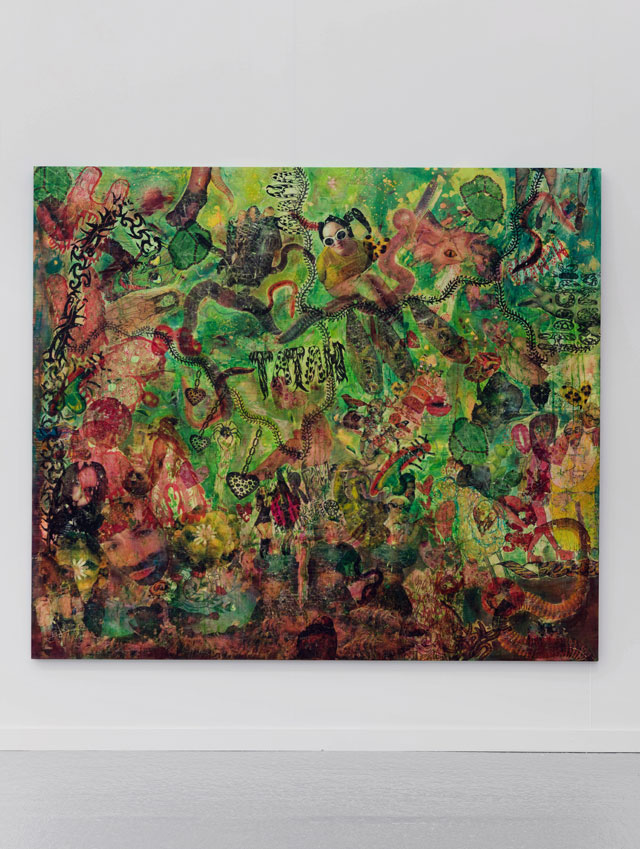
.jpg)
.jpg)
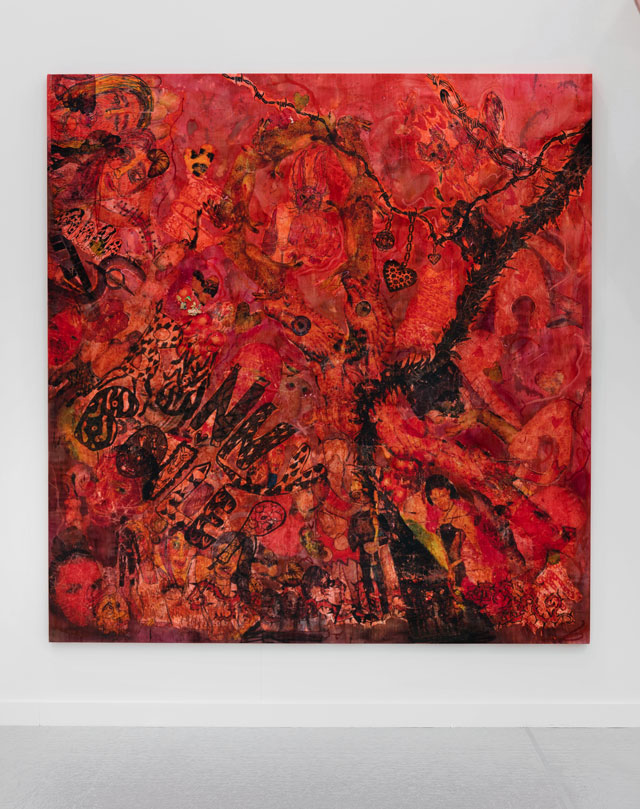
.jpg)
.jpg)
